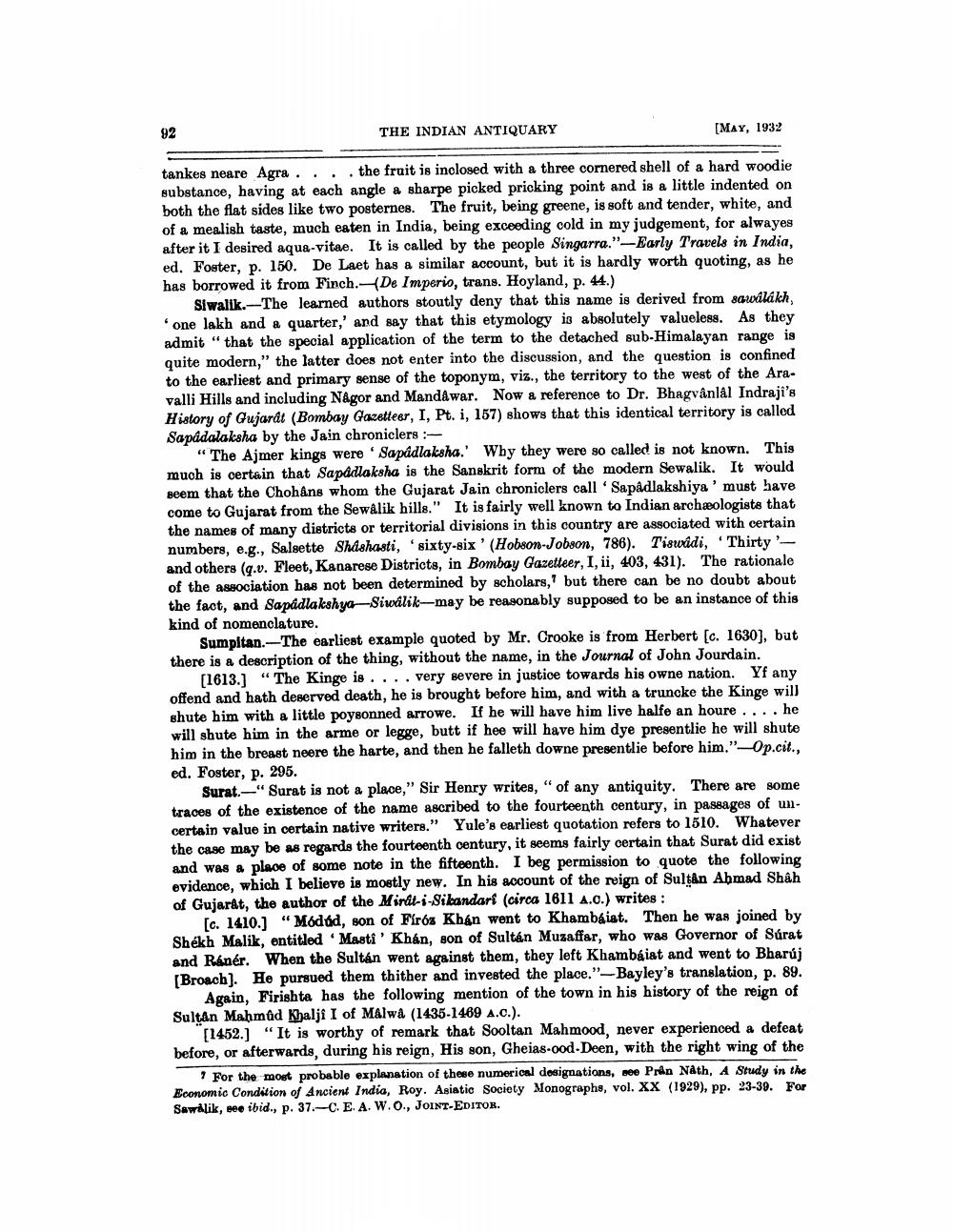________________
92
THE INDIAN ANTIQUARY
[MAY, 1932
tankes neare Agra .... the fruit is inclosed with a three cornered shell of a hard woodie substance, having at each angle a sharpe picked pricking point and is a little indented on both the flat sides like two posternes. The fruit, being greene, is soft and tender, white, and of a mealish taste, much eaten in India, being exceeding cold in my judgement, for alwayes after it I desired aqua-vitae. It is called by the people Singarra."-Early Travels in India, ed. Foster, p. 150. De Laet has a similar account, but it is hardly worth quoting, as he has borrowed it from Finch.—De Imperio, trans. Hoyland, p. 44.)
Siwalik.-The learned authors stoutly deny that this name is derived from sawálákh, one lakh and a quarter,' and say that this etymology is absolutely valueless. As they admit" that the special application of the term to the detached sub-Himalayan range is quite modern," the latter does not enter into the discussion, and the question is confined to the earliest and primary sense of the toponym, viz., the territory to the west of the Aravalli Hills and including Någor and MandAwar. Now a reference to Dr. Bhagvânlal Indraji's History of Gujardt (Bombay Gazetteer, I, Pt. i, 157) shows that this identical territory is called Sapadalaksha by the Jain chroniclers
"The Ajmer kings were 'Sapádlaksha.' Why they were so called is not known. This much is certain that Sapaellaksha is the Sanskrit form of the modern Sewalik. It would seem that the Chohans whom the Gujarat Jain chroniclers call 'Sapadlakshiya'must have come to Gujarat from the Sewalik hills." It is fairly well known to Indian archæologists that the names of many districts or territorial divisions in this country are associated with certain numbers, e.g., Salsette Shashasti, 'sixty-six ' (Hobson-Jobson, 786). T'iswadi, Thirtyand others (q.v. Fleet, Kanarese Districts, in Bombay Gazetteer, I, ii, 403, 431). The rationale of the association has not been determined by scholars, but there can be no doubt about the fact, and Sapádlakshya-Siwalik-may be reasonably supposed to be an instance of this kind of nomenclature.
Sumpitan.-The earliest example quoted by Mr. Crooke is from Herbert [c. 16301. but there is a description of the thing, without the name, in the Journal of John Jourdain.
(1613.) “The Kinge is . . . . very severe in justice towards his owne nation. Yf any offend and hath deserved death, he is brought before him, and with a truncke the Kinge will shute him with a little poysonned arrowe. If he will have him live halfe an houre .... he will shute him in the arme or legge, butt if hee will have him dye presentlie he will shute him in the breast neere the harte, and then he falleth downe presentlie before him."-Op.cit.. ed. Foster, p. 295.
Surat.-"Surat is not a place," Sir Henry writes," of any antiquity. There are some traces of the existence of the name ascribed to the fourteenth century, in passages of uncertain value in certain native writers." Yule's earliest quotation refers to 1510. Whatever the case may be as regards the fourteenth century, it seems fairly certain that Surat did exist and was a place of some note in the fifteenth. I beg permission to quote the following evidence, which I believe is mostly new. In his account of the reign of Sultan Ahmad Shah of Gujarat, the author of the Minit-i-Sikandari (circa 1611 A.c.) writes :
fc. 1410.) "Módód, son of Firoz Khan went to Khambaiat. Then he was joined by Shekh Malik, entitled Masti' Khán, son of Sultan Muzaffar, who was Governor of Surat and Raner. When the Sultan went against them, they left Khambaiat and went to Bharúj [Broach). He pursued them thither and invested the place."-Bayley's translation, p. 89.
Again, Firishta has the following mention of the town in his history of the reign of Sultan Mahmûd Khalji I of Malwa (1435-1469 A.C.).
[1452.) “It is worthy of remark that Sooltan Mahmood, never experienced a defeat before, or afterwards, during his reign, His son, Gheias-ood-Deen, with the right wing of the
7 For the most probable explanation of these numerical designations, see Prin Nath, A Study in the Economic Condition of Ancient India, Roy. Asiatic Society Monographs, vol. XX (1929), pp. 23-39. For Sawalik, eee ibid., p. 37.-C.E.A.W.O., JOINT-EDITOR.




